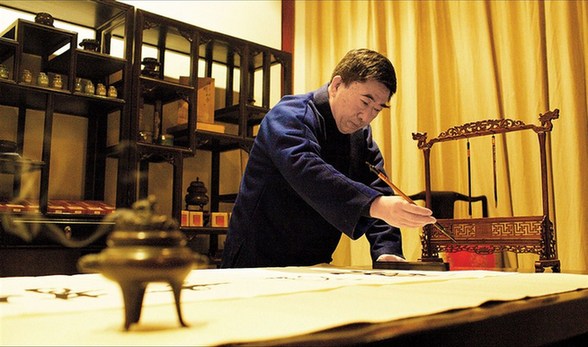 |
|
Incense master Fu Jingliang practices calligraphy to the company of incense at his Huitong Hall of Incense in Beijing. [Guo Yusong]
|
When Fu Jingliang, founder of China’s modern incense culture, was a boy of about 5, he mistakenly tossed a piece of precious agarwood used for incense into a stove for cooking.
His grandfather was furious, telling him the fragrant heartwood (chen xiang 沉香), also known as aloeswood, was the most precious in the world, valued for its benefits to health and meditation.
“That was the first time I became aware of chen xiang and years later incense would become my lifelong passion,” says Fu in an interview with Shanghai Daily at his studio in Beijing.
Fu would remember that later when his wealthy family’s home and its trove of agarwood were burned during the “cultural revolution” (1966-76).
Fu would go on to become an esteemed jade carver, a distinguished calligrapher and painter, even a health expert advising some of China’s leaders in the 1980s and 90s.
Today, the renaissance man in his 50s is dedicated to reviving and reinventing China’s traditional incense culture. He writes, teaches and makes his own incense. “Today people mostly use incense for pleasure but originally it was used for health, to balance yin and yang energies and balance the mind,” he explains.
Burning calligraphy to burn incense
By the late 1980s he was already an accomplished painter and calligrapher, and many Japanese connoisseurs bought his calligraphy work and paintings.
But he burned all his calligraphy and paintings to make way for incense.
“I felt China’s traditional culture was reviving at that time and that incense was its life’s blood,” says Fu, who at that time was teaching at a prestigious calligraphy school that he founded in Ji’nan, capital city of Shandong Province.
“To burn my calligraphy and paintings was like a brave man cutting his own wrists. I burned them so I would have no way to return from my new path of exploring incense,” he says.
Although he realized the importance of incense in traditional culture, there was little coherent and systematic scholarship on incense and its history.
As a calligraphy teacher, he had traveled across China to study the writing carved into cliffs. “It occurred to me that, as with cliff calligraphy, I should do some archeology to understand traditional incense culture,” he says.
We Recommend:
